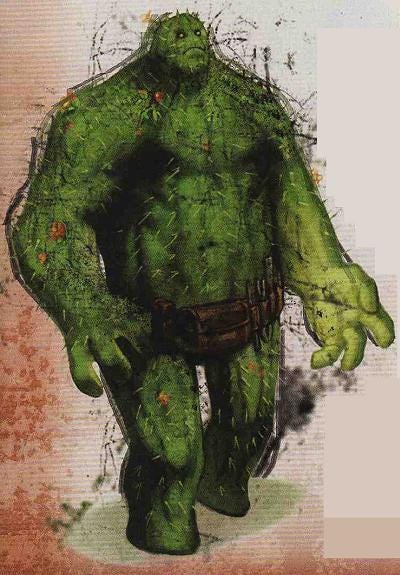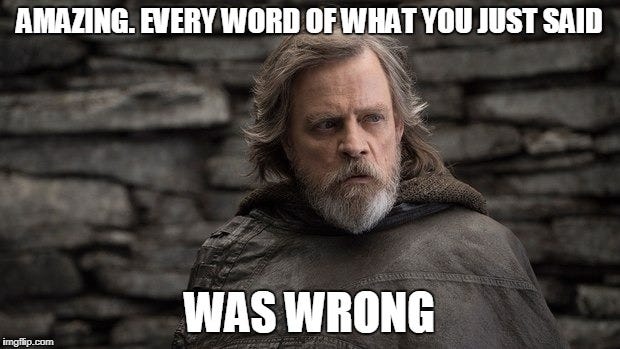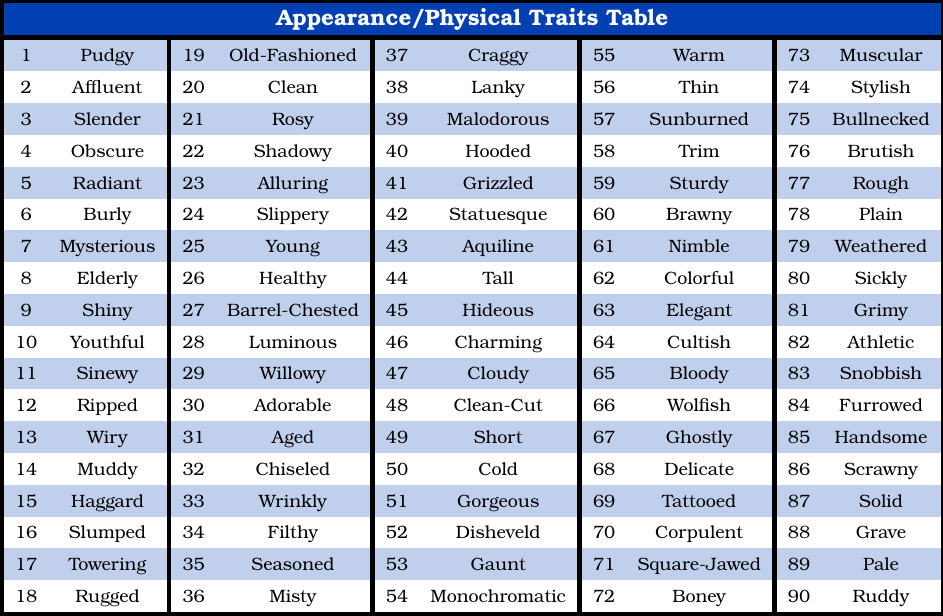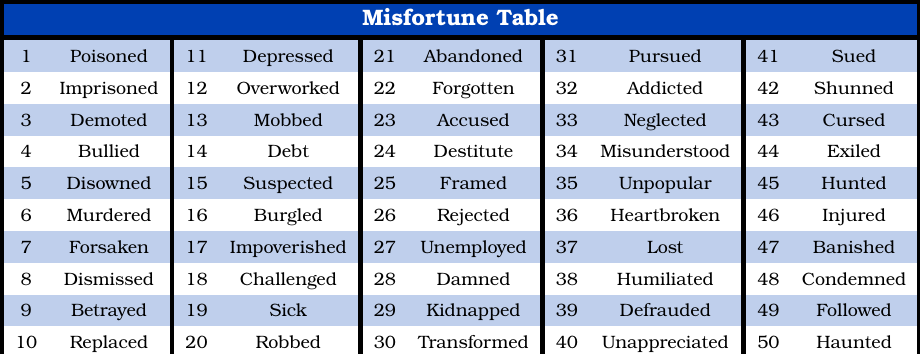Anti-Patterns in TTRPGs: Terminally Unique PCs and Main Character Syndrome
Or "Why can't you just be normal?!"
This time I want to cover two related and reinforcing anti-patterns “Terminally Unique PCs” and “Main Character Syndrome.” As a refresher allow me to give a definition of an Anti-Pattern:
“a common, well-intentioned response to a recurring problem that is at best ineffective and usually highly counterproductive.”
In my opinion both of these issues are actually symptoms of a veritable onion of layers of deeper anti-patterns in the conventional games and cultures of TTRPGs, but they also meet the above definition by themselves and are the easiest to see; so here we go.
Terminally Unique PCs and Misplaced Player Agency
What is a “Terminally Unique PC” you ask? It is a PC that is made in such a way that it inhibits the game from running well simply by being too “out there.” This can be the result of a number of factors, including dissonant PC race, dissonant class, crazy backstory, weird PC quirks and many other issues. The most of a common surface level causes of a “Terminally Unique PC” are race and/or class being wildly dissonant with the rest of the game or their combination just being entirely incoherent. If a player makes a ‘Fox-kin Ninja with laser pistols’ in a game set in the Roman Empire, that is a “Terminally Unique PC.” Most of the time it is more subtle than that though, something like “My PC is a Chaotic Good Paladin” or “I’m the only Good Aligned Orc/Drow/Vampire/other-evil-race in the world,” or similar levels of exceptional uniqueness that will cause problems for the game world. (For a good reference on Evil Races in RPGs see Alexander Macris’s video“Should Your RPG Have Innately Evil Races?” or Ryan Howard’s essay “Through a Glass Darkly.” ) While insane backstories are a thing, they can usually be mostly ignored if they are too far out there, the other issues are less easy to ignore.
You might already be able to see how this is “highly counter productive,” but even if the GM just ignores the Terminally Unique PC’s oddness as much as possible, that is “at best ineffective,” at least as far as whatever the player was trying to accomplish by making one.
But riddle me this, if making “Terminally Unique PCs” really is an anti-pattern, then what problem are the players attempting to solve by making “Terminally Unique PCs?” What ill are they are trying to remedy? I’ll get back to that in a bit.

I have seen some preposterous party compositions in TTRPGs as I briefly recounted in the introduction to this series. For reference here is the relevant part of that article:
Why EXACTLY would a random talking-Crow magic user, a lawful-good Dwarven barbarian, a psychic goblin, and a chaotic-neutral human cleric of the god of death, who all have their own complicated backstories that have ABSOLUTELY NOTHING to do with each other all go adventuring together? Maybe some forced situation like prison or a surprise invasion by ... something? But even if successfully forced together for a short time, why would they stick together? Yes, I have actually seen that exact setup at a real in-person Pathfinder game I ran back in the day (2014), and unsurprisingly that game did not last long.
Aside from the Human cleric, I consider ALL of those PCs Terminally Unique. Even the barbarian. Barbarians are not allowed to be lawful in Pathfinder 1e, so he was the only lawful one in the whole world/universe (and I stupidly allowed it). I will freely admit I am not and was not the worlds best GM, and that my players were not top notch either, but even given all that this situation should never have happened. I was encouraging this anti-pattern as the GM without even knowing it was one.
How did I encourage it? I did so by telling the players “You can be any race, class and alignment you want, just remember if you can use it so can I.” Since I was confident I was far better at the mechanics of the game than the players were, I figured why limit them? It wasn’t like they were going to out min-max me and break the game mechanically. This was a great mistake as “Terminally Unique PCs” killed my game through destroying the possibility of coherent world, setting, and PC-to-NPC and PC-to-PC iterations; not through breaking the game mechanics. For TTRPGs the ability to somewhat accurately guess and assume how the world will work is absolutely crucial to having a world the players can engage with, and from my observations that engagement keeps the game going. The problem is that scanty modicum of predictability is VERY hard to have that if things in the game are openly insane and contradictory (how exactly do phychic Goblins on average react to talking Goblin-sized wizard crows?). The players and GM have to be able to reasonably guess what the outcome of some action will be (given the information they have), which becomes nearly impossible as the setting gets more and more insane. How exactly does the setting of Ancient Rome change with “Ninja Fox-Kins” or laser pistols in it, and how would people react to them? To be very charitable, it’s hard to say.
What caused this mess was I fundamentally misunderstood what people liked about TTRPGs, and set in motion rules that encouraged this nonsense in a system that already encouraged that same nonsense (Pathfinder 1e).
Back then I naively thought that for the GM a TTRPG should primarily be a vehicle of expression through storytelling and worldbuilding, and for the players primarily a similar vehicle for expression though how they build a pre-concieved character concept, how that character interacts with the GM’s forced story and setting, and how that character is mechanically manifested into the game through stats/classes/feats/skills etc.
In hindsight, this was at least partially the result of bad incentives cascading from a major anti-pattern found in most TTRPGs and TTRPG subcultures that I call “Misplaced Player Agency.” It is here we run into
’s “Agency Theory of Fun,” which can very roughly be summed up as: it is fun to have self direction and to make meaningful choices that have a real effect, and these choices need a real and somewhat predictable chance of failure. Understanding this is critical to understanding what people like about TTRPGs.When a game has “Misplaced Player Agency” it is not that the players have no agency or self expression in the game, it’s that that agency and self expression is concentrated in the wrong areas of the game. It most commonly manifests as too much agency in character generation and almost no agency to effect the game world as they see fit. This demonstrates a misunderstanding of one of TTRPGs core strengths, specifically the ability for the players to come up with and attempt almost any solution to a problem they face using the rules of the system and the judgement of the GM. This strength is otherwise stated as complete player agency in action during the game for good or ill, subject to the rules and GM. You can TRY to do literally anything you can think of, even though it may not work. This is THE main strength of TTRPGs over other interactive media such as video games.
Why does this misunderstanding happen? My primary conjecture is that too little player agency in the game world causes players to naturally seek it elsewhere in the game. If the players can’t freely attempt to effect the world of the game, they move their attempts at agency to the nature of their PCs which is, in that case, really the only part of the game they do roughly control.
If most people think like I previously did, that player creation is one of the few areas where it is even POSSIBLE to have total player agency, then it is logical for them to conclude that player agency in character creation should be maximized. That is a large but understandable error.
This faulty assumption also seems to have roots in habits from certain RPG videogames where it is actually true that the player can only have a minimal effect on the story but a large effect on how the character is grows in mechanical power. Try having any agency aside from grinding levels in the infamous ‘hallway’ and ‘teenage angst simulator’ simulator that is Final Fantasy 13.
To me, this implies that this anti-pattern is usually (though not strictly necessarily) downstream of a truly foundational anti-pattern which I will cover later called “Railroading;” which is the GM giving the players no agency or fake agency to force a pre-concieved story of his to occur.
Thus my answer to “what is the problem players are trying to solve with ‘Terminally Unique PCs’?” is simplely: lack of proper player agency. The fact that the solution of ‘make Terminally Unique PCs’ doesn’t work and usually makes things worse is why I consider it an anti-pattern.
How does this result in vampiric, talking cactii you ask? In a game with “Misplaced Player Agency” the players are greatly incentivized to focus on the wrong thing. That wrong thing is something like “how to be maximally expressive via character build and character uniqueness” as opposed to “how to best actually PLAY the game and interact with the game world.” The focus has shifted from the game, to the meta-game of character building. Soon the players start relentlessly searching for ever more unique and/or powerful builds via extra classes, races, feats, splat books, and homebrews to maximize their creativity and self expression (and thus agency) instead of caring about the actual game. That shift in focus has some serious cascading effects that eventually culminates in “Terminally Unique PCs.” Why? Well, recalling the “Agency Theory of Fun” this is THE place where they get to have agency and thus fun in a game with “Misplaced Player Agency.” Making characters is the part of the game most open to them in this case, while the rest is to a large extent shut off.
Interestingly, while I think “Misplaced Player Agency” is a root cause of “Terminal Uniqueness” in PCs, by itself it’s actually not enough to cause “Terminal Uniqueness” to be COMMON in PCs. That requires an anti-pattern endemic to GMs that I call “Pathological Player Options” as well. You see, if the GM also thinks that the player’s agency in Character Creation should be maximized then he will allow almost any option that is in any official splat book expansion to the game, since he has no logical reason not to do so aside for a particular distaste for some small set of absolutely horrid options.
Giving the players too many options that were mostly pathological is exactly the mistake I made in my example I recounted earlier. And I did that because I subconsciously assumed that was where the players get to have fun/agency.
Unhelpfully, TTRPG companies tend to encourage a plethora of unhelpful player options since they can make a lot more money off selling splat books full of character options to players, than they can selling well designed rules to GMs once every 5-15 years. After all, there are a lot more players than GMs just by the nature of the game. Since there is more money to be made off encouraging this issue, the average game system does absolutely nothing to discourage it. For example, D&D 3rd edition had around 30 extra books published explicitly as extra character options, and far more than double that when you account for setting or terrain specific splat books. Most of these books add extra playable Races, Classes, feats, spells, etc and can drastically increase the number of playable races and classes to be way outside what even the most ardent lover of “gonzo” fiction would dare accept in a single setting. By the end you are looking at ~100 playable BASE classes (not even counting multi-classing and prestige classes!) and ~400 playable races many of which are completely ridiculous for a PC, like the “Ooze Para-Genasi:”

See for yourself here. Its nuts. I’m pretty sure Pathfinder 1e was even more insane on this front, but I refuse to even try to count that all up.
Now having all these options is not the issue (I mean okay, allowing Ooze Para-Genasi as PCs is an issue no matter what), it’s having all these DISSONANT options AT THE SAME TIME that is the issue. That is what I mean by “Pathological Player Options.” This anti-pattern is trying to cover over the other anti-pattern of “Misplaced Player Agency” by giving players tons and tons of character options. Allowing too many DISSONANT options is a common mistake in TTRPG culture as much as it is in TTRPG systems. Its not just the fact that you can play a Shadowcaster who is a talking Toad that is also a Half-Celestial, it’s the fact that IF if you drop that thing in normal-ish campaign with a generic “D&D implied setting” world, then the game starts to fall apart due to no longer being able to have any semblance of sanity with respect to setting. If you have a party full of “Terminally Unique” PCs it makes the whole game make no sense. You see, the GM suddenly has to either ignore that and pretend the PC is basically just normal, or make the world make sense with all these races and classes in it, and that with a bunch of “Terminally Unique” PCs that is down right impossible if you want anything other than a one-shot game inside 40k’s Warp.
My point is NOT that player options in character creation are inherently bad — it’s that they have to be restricted to a small, thematically coherent subset for any given campaign or you end up with nearly all options being “Pathological Player Options.” You could run a game where EVERYONE (including 90%+ of the NPCs) is a walking, talking, sentient Saguaro Cactus in some infinite flatworld, fever-dream fantasy version of the American Southwest where water is worth more the gold. Hell, it might be a fun, 3-4 session change-up between real campaigns. However it gets really messy almost instantly if every PC is a different dissonant race and class combo from wildly different milieus. Try adding a PC who is a Sahuagin Viking to the cactus game and see how that goes.
On a more practical level, in the AD&D DMG, Gary Gygax asserted that campaigns should be “humanocentric.” Because well, that works the best for everyone involved in the game and allows for the smoothest role-playing.
ADVANCED D&D is unquestionably “humanocentric”, with demi-humans, semi-humans, and humanoids in various orbits around the sun of humanity.
…
The game features humankind for a reason. It is the most logical basis in an illogical game. From a design aspect it provides the sound groundwork. From a standpoint of creating the campaign milieu it provides the most readily usable assumptions. From a participation approach it is the only method, for all players are, after all is said and done, human, and it allows them the role with which most are most desirous and capable of identifying with. From all views then it is enough fantasy to assume a swords & sorcery cosmos, with impossible professions and make-believe magic. To adventure amongst the weird is fantasy enough without becoming that too! Consider also that each and every Dungeon Master worthy of that title is continually at work expanding his or her campaign milieu. The game is not merely a meaningless dungeon and an urban base around which is plopped the dreaded wilderness.…
By having a basis to work from, and a well-developed body of work to draw upon, at least part of this task is handled for us. When history, folklore, myth, fable and fiction can be incorporated or used as reference for the campaign, the magnitude of the effort required is reduced by several degrees. Even actual sciences can be used — geography, chemistry, physics, and so forth. Alien viewpoints can be found, of course, but not in quantity (and often not in much quality either). Those works which do not feature mankind in a central role are uncommon. Those which do not deal with men at all are scarce indeed. To attempt to utilize any such bases as the central, let alone sole, theme for a campaign milieu is destined to be shallow, incomplete, and totally unsatisfying for all parties concerned unless the creator is a Renaissance Man and all-around universal genius with a decade or two to prepare the game and milieu. Even then, how can such an effort rival one which borrows from the talents of genius and imaginative thinking which come to us from literature?
In summary, as the PCs get more “out there” in character concept the harder the game is to run, and at some point it becomes a practical impossibility to have more than an ultra-gonzo, one-shot game (in or out of the Warp).
This is why “Terminally Unique PCs” are a serious anti-pattern and why they kill games.
Before I get to formally presenting my solutions, (which are not so subtly apparent in the above), I want to cover the other titular anti-pattern of this post.
Main Character Syndrome and Ludicrous PC Backstories
“Main Character Syndrome” is when a player makes a “super special” PC who is designed to be the “main character” of the story, and thus tries to hijack the game, ostensibly to make the whole game focused on their PC. Basically they want to be the center of attention, sometimes actively, and sometimes passively, and make all the other PCs and players the supporting cast. The offending player may or may not be aware of this.
Some common tropes of main character syndrome:
The PC is secretly the son of the King of Wherever, or some highly respected part of the nobility.
The dark, mysterious, edgy Loner who is also super badass.
The PC who is level ONE has so much history that he has a powerful villain as a personal nemesis (at level ONE), and ties to make the story about that.
Has 15 pages of preposterous and impossible backstory for a level ONE PC. (“back then we was the General of the Kingdom’s army, but …”)
In his backstory he came into possession of this great family heirloom artifact but its “a secret” or “dormant” or “needs to be protected to stop Armageddon.”
Super unique person since he is the “only ____ who is ____” (“I’m the only good Drow” was an anti-classic back in the day)
Bossing the other players/PCs around constantly.
Tries to be the center of every interaction ( such trying to be the person to open any loot, or monologue to any NPC).
Interrupting other players/PCs constantly, so they can talk more.
You get the idea.
Main character syndrome is something that is partly caused by anti-patterns and partly cause by bad or merely inexperienced players. The reason that I think it is related to “Terminally Unique PCs” is that the same main anti-pattern underlies it, “Misplaced Player Agency.” Why do I think this? Well most of the time it is caused by a player making an absolutely ludicrous background for his PC. Why do that? One reason could be narcissism, but this is actually quite rare. A more common is just that a new player who is inexperience playing TTRPGs that does not know the average PC is not FATED like King Arthur to be king (though with some luck/providence he could be King). In most of the above cases you, the GM, can just sit down and talk to the player making these PCs and solve this problem.
So where does “Misplaced Player Agency” come into all this you ask? I posit that most players of a “Main Character Syndrome” PC are doing this to try to get some wants met. I think PC usually wants: better PC mechanics/ game interactions, a lot more interaction with the game world, other players, and NPCs, and some tangible say in the direction of the game and world. Why do I think this? The player wouldn’t try to be important in the game world if they are uninterested in it. Similarly, the player would not try to dominate all conversations if their desire for role-play was satiated. Again, they would not try to open all the treasure if there is a high chance it was trapped and might one-shot them unless they can mitigate the risk; that is an issue of missing mechanics. Lastly, they wouldn’t be trying to be a big part of the world/story if they were not interested in those things.
I posit that they are trying to get those things by making a “Main Character Syndrome” PC, because they don’t know another way to get them, and the mechanic of letting players write arbitrary backstories makes it easy to TRY to achieve that end in this way. They of course fail to accomplish this goal, its an anti-pattern after all.
As I said this is not always the cause, but it is more often than you would think. On the bright side, since this is PARTLY a mechanical problem, both in TTRPGS and in the culture around them, we can at least PARTLY fix it by intervening mechanically to discourage the behavior.
Players with “Main Character Syndrome” are generally interested in the game, it is just coming out in unhelpful ways. They are, on some level, trying to solve the problem of wanting more interaction out of the game than they are getting. This interest needs to be contained, channeled and used to benefit the game and the game world as opposed to harm it.
It obvious why “Main Character Syndrome” PCs are bad for the game, so allow me to present the best solutions I have found.
The Solutions:
I recently opined on X/Twitter:
I have come to think that player freedom in chargen should be greatly restricted, but player freedom while playing should be maximized. Rolling 3d6, down the line, with stat requirements for classes is great for this. So are randomly rolled appearance, height, weight, etc.
This is, hilariously, the exact opposite of what I thought when I first played TTRPGs back in the D&D 3.0 days. Live and learn lol.
This is the best solution to “Misplaced Player Agency”, move the player agency back to when the the players are actually playing the game and get it out of character creation.
We want to solve this anti-pattern by discouraging and disallowing the harmful behavior and encouraging good behavior. A shift in the incentive structure of the game and meta-game will do this.
Lets start with steps to discourage the harmful behavior.
How to Get the Unnecessary Agency Out of Character Creation.
The best way to discourage the “Terminally Unique PC” problem is to make characters (usually) start as destitute (for an adventurer) nobodies and to always make character generation as random and procedural as possible, but with appropriately sized bounds that keep the party interesting but believable. This way you get a character with thought provoking stats, and an odd combinations of physical and other characteristics that a player would likely never make themselves, which then ignites the player’s imagination. As the GM you want to keep things constrained enough so that players at least have a reasonable chance of working together in a believable way. This means all the generated characters should be similar enough that they could reasonably interact, and have on average a similar enough view on the world that they could reasonably understand each other at least a little bit, and still be different enough to be interesting.
In a similar vein, the solution to PCs with “Main Character Syndrome” is randomly generated vague character backgrounds. I also like what one of the Black Lodge Games guys opined (can’t recall which) “Your backstory is levels 1-3.” The problem is not actually exceptional or gifted, or fateful PCs, the issue is people who should not play those characters are the people who generally want to play them. Making players use stats rolled down the line also helps a LOT with this, since the resulting PC is not really the players own concept anymore.
Doing all this is sometimes called a “Character Discovery System” instead of a “Character Creation System,” and I have become a big fan of them. In fact I think a Character Discovery System is the OBJECTIVELY best way to make PCs.
Some concrete changes you can make to switch to a Character Discovery System, specifically to address these issues in your games:
For each Campaign, restrict the total number of playable races to a COHERENT set of 4 or less, and make the players openly roll their PC’s race on a random table that you, the GM, generate for that specific campaign.
Have the players openly roll stats, and do so in order. No exceptions. Preferably something low to midrange, like 3d6 or at most 4d6 drop lowest. Rolled stats in order are absolutely crucial.
If your game does not have Race and Stat requirements for classes, add them. When done well this helps narrow down, but not outright determine, the PC’s class when combined with stats rolled in order.
See AD&D 1e or B/X, Old School Essentials, or OSRIC for examples.
For each Campaign, restrict the classes to something that makes sense for the campaign milieu. The exact number can vary quite a bit from table to table, game to game, and GM to GM. Let the players choose any class for their PCs that said PC qualifies for from this list.
Have the players openly roll for their PC’s appearance, personality, height and weight. I provide example tables for this below.
Do NOT allow player-written or custom Character Backgrounds. Instead make the players openly roll on one or more tables for this. This can be something simple like a single “Previous Misfortune” table that explains why the PC is willing to try adventuring or something complex like a restricted version of the “Central Casting” books (or similar) to procedurally generate a complex background. I prefer the single table.
The “Central Casting” books are long out of print and not for sale NEW in any form, digital or print at least as far as I know; you can *ahem* ‘find’ PDFs online if you know where to look.
Optional but Recommended: Have a minimum of 2 PCs per player. This really discourages both “Terminally Unique PCs” and “Main Character Syndrome” by forcing the player to have multiple allegiances to the PCs.
Optional: assuming you want the PCs to sort of get along (which you may not):
For each Campaign, restrict alignment to a small set that shares one characteristic. Example You can be either Lawful Good, Lawful Neutral, or Lawful Evil. Maybe add one more alignment that is close to the others (usually “True Neutral”). You can easily make a similar set with Good, or Chaotic, or Evil as well.
Optional: If Nobility is a thing in your setting, AND its not covered by one of the other random dice rolls.
Have the players openly roll 1d100. On a 95-98 the PC is “disgraced lesser nobility” of some form like a disowned Son of a Knight. On 99-100 they are some form of “disgraced nobility” like a disowned son of an Earl or Count. For 1-94, they are a regular old commoner. This solves many of “Main Character Syndrome” plot lines instantly, while occasionally giving some interesting backstory.
Here are some of the tables I personally use for this (borrowed and lightly modified from this opensource online character creator by EvilTables) :
I am not going to provide a PC Height and Weight table since that varies too much by race. Just make one for your selected set of races. For an example, for Human PCs I use:
Male: 5ft +2d12 inches
Female: 5ft +1d12 inches
Putting all this together will make it VERY, VERY difficult to end up with either of the titular anti-ptterns discussed previously.
Now on to the REALLY controversial Part.
Giving Game Agency BACK To The Players
I’m keeping this section short as it can/will quickly to bleed into discussing more of the anti-patterns I listed in the introduction specifically, “Fake Player Agency and Lack of Consequences,” “Boring exploration, Boring Lairs, and Boring Dungeons,” “The World Feeling Like a Joke or Afterthought,” which I will cover in depth later.
First off TTRPGs work best as Sandboxes. Westmarches. Hexcrawls with truly random encounters. Braunsteins. The #BroSR is basically right about this style of game and the techniques that can make those games better.
Throw balance out the window, the game world NEEDS to be dangerous, surprising, and wild. Yes dungeon crawling is a big part of that, but you the GM need to relax the storytelling and let the players drive the campaign. You need to make the game world NOT revolve around the PCs so the players actually have something INTERESTING to explore, discover, and interact with.
As the GM, be more like a “world outliner” than a “world builder.” “Oh there’s some ruins in that hex, and they have a Frost Brand in them” is all you need for a hex to contain some ruins. Honestly, you may not even want to predetermine the treasure, hell I usually don’t do that last part.
There are a lot of hexcrawl resources out there that can help you get started, like here. Similarly if you need help to make things on the fly, those tools exist too if you look for them. Need a town, village, island, or small dungeon immediately, go here. Need an entire BASIC hexcrawl in 1 minute? Say hello to Hexroll.
Having a rough map makes it so you can let the players see ruins, towers, etc from a long distance and decide for themselves if they want to go there. Be impartial to which things the players want to do and explore. Drop OCCASIONAL hints and rumors about treasures and lost cities. Let the players go wild and use the random tables to run it all. That encourages good player behavior, especially if they have multiple PCs with differing goals.
Lastly let players suffer the consequences of their PCs action for good or ill. Be impartial between PCs and the rest of the world. This greatly enhances player engagement with the world.
Only roll in the open so you can’t fudge a die roll and they players know everything is above board. I know it sounds crazy but players appreciate knowing it was purely the dice that killed their PC or gave him a +4 sword.
Next let the PLAYERS (NOT PCs) run factions in the world, and make the world live with 1:1 timekeeping. Make the gameworld more important than any PC or party of PCs.
You get the idea, go all in on the core strength of TTRPGs player agency. For that to work, the world needs to feel and act ALIVE and not just like it only exists for the PCs and only when the PCs are walking by.
I hope you can see how these solution give players guardrails to avoid “Terminally Unique PCs” and running PCs with “Main Character Syndrome,” as well as enough agency they will have little interest in doing those anti-patterns.
So concludes my TTRPG heresy for today. Till next time.
If you like this, consider following me on x.com/ThalassiosX2












Sly Flourish's City of Arches by Michael E. Shea is a campaign setting designed specifically to allow Terminally Unique PCs and have it all make sense.
"Characters of any race, ancestry, species, class, or background can find a place in the City of Arches."
He tries to mitigate Main Character Syndrome by stating in bold text, "Working together with your companions, you protect the city as you seek out the adventures it has to offer. "
Both quotes are from Appendix E, City of Arches Player's Guide, on page 153.
I do not regret my purchase. Yet the irony is not lost on me.